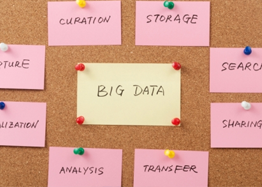How Advanced Data Visualization is Unlocking the Doors to Big Data
For C-suiters – many of whom are accustomed to getting their data on nothing more sophisticated than an Excel spreadsheet – the rise of large-scale analytics has been attended by the added challenge of making sense of all the new information at their disposal. Bringing complex trends into focus and leveraging them into actionable intelligence requires new platforms for not only collecting and filtering information, but for presenting it in meaningful and compelling ways that don’t overwhelm the average non-analyst user.
Indeed, a 2012 report from IDG Research identified a lack of analytical skills/expertise as the leading challenge complicating the effective utilization of Big Data.
“A lot of existing Big Data techniques require you to really get your hands dirty; I don’t think that most Big Data software is as mature as it needs to be in order to be accessible to business users at most enterprises,” said Paul Kent, vice president of Big Data with SAS, who was interviewed for the report.
Compounding that challenge is the increasing demand for fast response times to changing market dynamics; this is driving a push for so-called “self-service” business intelligence, which requires getting the right information into the right hands and in just the right format.
To this end, advanced data visualization has emerged as a critical element of business intelligence. Unlike traditional business graphics, such as bar- and pie-charts, ADV tools feature dynamic, interactive graphics and real-time updates in formats (primarily GUI dashboards) designed to appeal to the average business user.
As research and consulting firm Aberdeen Group describes it:
“Traditional business intelligence solutions, often referred to as managed reporting, can be very efficient at providing updates on standardized metrics and key performance indicators. However, managed reporting is less adept at responding to unanticipated and often time-critical information needs.”
The facilitation of “ad-hoc” data analysis – and the improved decision-making it powers – have been cited as the top two benefits of advanced data visualization.
According to IDG, advanced data visualization is characterized by highly interactive graphics that incorporate data visualization best practices; integrated, intuitive, approachable analytics
capabilities; easy report building; and the ability to distribute insight via mobile devices and Web portals.
Similarly, Forrester Research identifies six characteristics of ADV that differentiate it from legacy models. These are:
· Dynamic data content
· Visual querying
· Multiple-dimension, linked visualization
· Animated visualization
· Personalization
· Business-actionable alerts
A 2011 survey from TDWI Research found that data visualization is credited for significantly increasing business user insights and “is prompting a cultural shift toward more analytic, data-driven business and operations by empowering users to explore, in a graphically inviting medium, data that was previously available only in tabular reports.”
To date, detailed forecast data on the emerging ADV market is scarce to nonexistent, but IBM forecasts that in 2013 there will be increased awareness of data visualization, leading to more requests for ADV information, demos and case studies.

